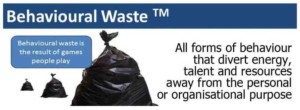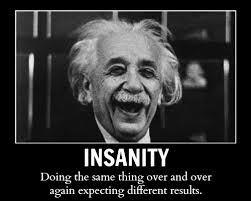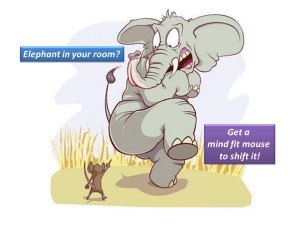From Poor to Peak Performance – Part 2
In Part 1 (click here to read it ) we questioned the Learning & Development (L&D) status quo and made a bold suggestion that knowledge training was in effect a complete waste of time. (But it wasn’t that bold as others have researched it in detail and if you Google it the evidence is out there – but don’t dig too deep as it may shock you.)
Here we look at the business reality and what could easily happen if an organisation were to take up our offer – it’s a GUARANTEED offer if the organisation wants to change. Because what you see in the picture below actually happens. And it starts to happen during the first workshop.
Current interventions – the reality
We know from the Gallup surveys that the vast majority of people in organisations are disengaged either passively or actively, and these are generally poor and ineffective performers who generate Behavioural Waste™.
So what difference would it make to your organisation if people stopped or reduced the behaviours and activities that cause Behavioural Waste™? What if they converted 1 hour a day from Behavioural Waste™ into being more engaged and increased productive time?
We know that L&D’s aim to ‘unlock people’s potential’ also does not work.
Should we simply lower our sights and seek to get a majority of people, the 87%, to become ‘just good enough’?
People regularly move between different performance states
We know that people, who are Mind Fit and have a Can-Do attitude, willingly perform to their optimum in different situations. All they need is a reason for doing so, have some control over what they do and how they do it. The optimum level will depend on the amount of experience a person has at that point in time. For most it may not be at a peak level. With the right conditions a person will at least be a good performer or even an excellent performer if that’s what they choose, and deliver value.
However, if the job is such that people find it boring and they can see no purpose in it then they will simply function and probably play games (business politics). What that means is they will probably be a poor and ineffective performer. In other words, one of the 87% of disengaged workers. Let’s face it, some jobs are repetitive in accounting, sales, IT etc and yet you’ll know of two people doing the same job – one who’s engaged and the other just functioning.
Performance Continuum
What if we looked at performance as a continuum? One in which employees could move from one end to the other at any moment in time depending on what the task is. Businesses mostly do this anyway and have terms like outstanding, good, average, needs help(!) applied to their teams.
While you’re reading this you might want to ask the question “Who goes to work deliberately to fail?”
Poor —— Just good enough —— Good —— Excellent —— Peak
Poor performers are ineffective and usually operate with a Can’t-Do or Won’t-Do attitude. They come to work and avoid what should be done or make excuses for not doing something. They generate most Behavioural Waste™. They are an expensive resource for the organisation but you can’t afford to lose them. In one hospital in the UK most nurse managers spent a majority of their day in meetings that were unproductive. That is cultural Behavioural Waste™ – which drags down the individual even if they are high performers!
Just good enough performers also have a negative attitude and do the bare minimum of what they should be doing. However, what they do is often what the organisation requires of them at a basic level. They are the moaners and blamers who spend a lot of time talking instead of working. These are the “jobs worth” types. In one Power Company we found engineers working for only 2 hours per shift whilst the rest of the time was spent avoiding real work.
Good performers have a Can-Do attitude and know why they are at work and want to deliver a good job that is of value. Their level of awareness is high and they will know what is going on around them. They will seek advice to improve and are willing to learn. Such employees are generally trustworthy and make good team members. The workforce on the Brompton Fold-up cycle assembly line are a perfect fit in here. They are very active, proud of what the company makes and like being part of the team.
Excellent performers go that extra mile. Not only will they deliver value but will routinely add value to their role. These people are innovative and look for new ways of doing things to improve effectiveness and efficiency. Many will be seen as the high flyers in an organisation. But don’t be fooled by rank! An unskilled person employed in a paint shop on a production line identified 25 improvements that could be made to the production process along the whole assembly line and over half were implemented. The company saved £100,000s.
Peak performers can be found in a myriad of roles in an organisation and elsewhere. They look far beyond their immediate role and constantly identify ways of improving their own performance and doing much more. Such people are driven to succeed. Peak performing managers do exist as Jack Zenger and Joseph Folkman have published in their latest research where these people drive results and employee engagement at the same time. Peak performers include London black cab drivers that have learnt ‘the knowledge’, comedians such as Michael McIntyre or top barristers. All have spent thousand of hours improving.
Where does your organisation fit?
 Think about these questions on a personal, team and organisation level:
Think about these questions on a personal, team and organisation level:
- Where on the continuum do you consistently operate from?
- What causes you to move your performance along the continuum in both directions?
- How much of your time at work do you deliver or add value?
The Business Reality
What we find is that that poor performers will at some time during a day move into ‘just good enough’ and that is just good enough for the business. However, these people are unlikely to remain there and will require constant supervision. If you were to ask them and show them life could be a lot better, as we do in every programme, most if not all will change their behaviour. No one goes to work to deliberately fail.
Good performers will sometimes move into excellent and occasionally into peak for a specific task or role. They will effortlessly flex between the three positive levels as required. What can stop them remaining good performers or more is systemic and cultural Behavioural Waste™. One of the culprits is simply poor leadership and that can cause them to slip to the negative end of the continuum in a heartbeat.
Your New Reality
What difference would it make to your organisation if people moved from poor and ineffective performers to become ‘just good enough’. Could this give an extra hour a day of productive time to deliver value for the organisation?
What difference would one extra hour per day per employee of focused performance make?
What would the impact be on leadership and supervision?
What impact would that have on sales, production, or on service delivery?
What would have to change to move people from ‘just good enough’ to ‘good’?
Do you want better engaged employees that perform better?
- Start by removing or reducing Behavioural Waste™ – personal, cultural and systemic
- This reduces and prevents poor and ineffective performance
- Identify what ‘just good enough’ performance is for all staff
- Link ‘just good enough’ to delivering value
- Encourage some people to be ‘good’ performers and for others ‘excellent’
While Gallup suggests 87% globally (UK 83%, USA 75%, Asia 90%) are disengaged, even if only 25% of employees in your organization are disengaged it is still worth starting at the beginning of the journey developing ‘just good enough’ performers.
Organisations live in the real world so it’s best not to be idealistic or have a utopian dream of unlocking people’s potential which becomes a meaningless statement as many providers do not know how to change attitudes and deliver results.
Would a paradigm shift from poor to just good enough performers be a good start for most? Poor leadership, given their impact might be the best place to start?






 Behavioural Waste™ – all forms of behaviour that divert energy, talent and resources away
Behavioural Waste™ – all forms of behaviour that divert energy, talent and resources away


















